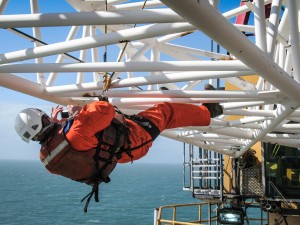HVDC Platform Inspections
 It could be a serious quiz question. What do the DolWin alpha, BorWin alpha and DolWin beta in the German section of the North Sea have in common? The only right answer would be: all three platforms were fully inspected by Den Helder-based Bluestream. For carrying out the HVDC platform inspections, divers, ROVs, multi skilled rope access teams as well as ultramodern drones were used.
It could be a serious quiz question. What do the DolWin alpha, BorWin alpha and DolWin beta in the German section of the North Sea have in common? The only right answer would be: all three platforms were fully inspected by Den Helder-based Bluestream. For carrying out the HVDC platform inspections, divers, ROVs, multi skilled rope access teams as well as ultramodern drones were used.
The first asset to be inspected was the DolWin alpha, the largest offshore conversion platform for windfarm energy in the German section of the North Sea. The platform was installed on a jacket consisting of six legs, and comprises five decks that rise 80m above the water surface. The jacket on which the DolWin alpha is mounted also had to be inspected. The inspection not only covered the section of the jacket protruding above the water, but also the six legs below water level. As an alternative for an ROV scope, Bluestream deployed the Cathodic Protection (CP) Drop Cell method for this particular activity.
In close consultation with the client, Bluestream also developed a reporting model for assessing any damage identified. Every item of damage, however small, can be derived from the report data and prioritised according to degree of seriousness. In this way, the client is able to work towards an effective planning model. A special software package was developed in house for user-friendly and rapid information processing. In this way, the client is able to work towards an effective planning model.
After successful completion of this first inspection Bluestream was awarded an order to inspect all accessible areas on the HVDC platform BorWin alpha as well. The total height of the BorWin Alpha is 84m, of which 62m consists of the support jacket. Unlike the DolWin alpha project, this inspection was carried out following a painting programme, leading to a shorter inspection period. The CP Drop Cell method was again used for this project. The extra challenge on this occasion lay in the fact that the legs of this platform were at an angle, as compared with the legs of the DolWin alpha, which run straight up and down.
In mid-2017, Bluestream received a further order to inspect the DolWin beta. This submersible floating platform is moored just 30m from the DolWin alpha. The concept behind this platform is different from that of the previous two platforms, which are mounted on separately installed jackets. The six legs of the DolWin beta are in fact an integral part of the platform itself. Bluestream was asked to carry out a general visual inspection using a drone operated by business partner Skeye. In just three days, pilots from Skeye inspected the outside sheeting, the legs and the underside of the deck of the DolWin beta platform using a drone. A small part of the inspection work still had to be carried out by one of Bluestream’s rope access teams. After all, there are always certain areas that require a close visual inspection. Drones are a complementary tool, and will never be able to completely replace rope access.
In September of this year, Bluestream returned to BorWin alpha for an extensive inspection of all components of the platform, both above the water and subsea. This time the work will not be carried out by drone but by rope access, backed up by ROVs.






